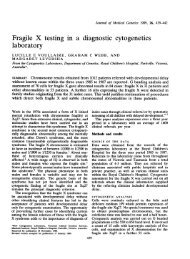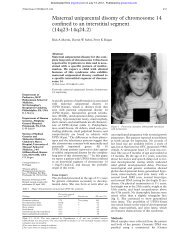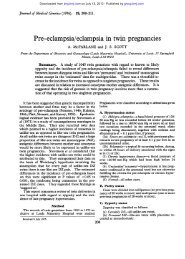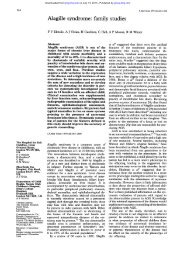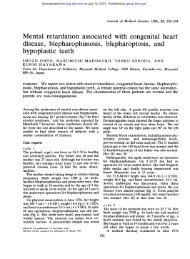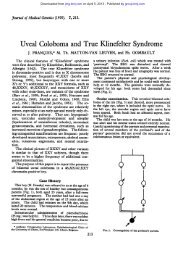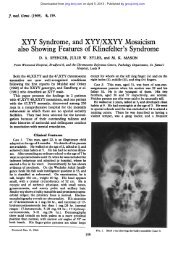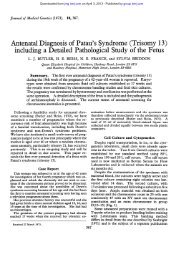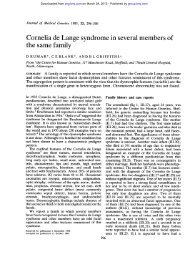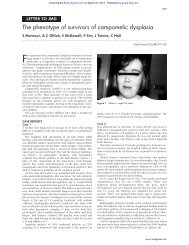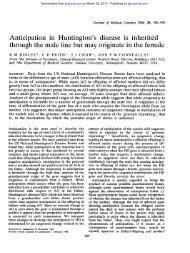Landouzy-Dejerine - Journal of Medical Genetics
Landouzy-Dejerine - Journal of Medical Genetics
Landouzy-Dejerine - Journal of Medical Genetics
Create successful ePaper yourself
Turn your PDF publications into a flip-book with our unique Google optimized e-Paper software.
<strong>Journal</strong> <strong>of</strong> <strong>Medical</strong> <strong>Genetics</strong> 1989, 26, 481-484<br />
An exclusion map for facioscapulohumeral<br />
(<strong>Landouzy</strong>-Dej erine) disease<br />
MANSOOR SARFARAZI*, MEENA UPADHYAYA*,<br />
GEORGE PADBERGt, MARGARET PERICAK-VANCE:,<br />
TEEPU SIDDIQUEt, G LUCOTTE§, AND PETER LUNTII<br />
From *the Institute <strong>of</strong> <strong>Medical</strong> <strong>Genetics</strong>, University <strong>of</strong> Wales College <strong>of</strong> Medicine, Heath Park, Cardiff<br />
CF4 4XN; tDepartment <strong>of</strong> Neurology, State University <strong>of</strong> Leiden, Leiden, The Netherlands; 1:Division <strong>of</strong><br />
Neurology, Box 2900, Research Park I, Duke University <strong>Medical</strong> Center, Durham, North Carolina 27710,<br />
USA; §Laboratoire de Ge'netique Moleculaire, INTS, 6 rue Ale\xandre Cabanel, 75739 Paris, France; and<br />
IlDepartment <strong>of</strong> <strong>Medical</strong> <strong>Genetics</strong>, St Mary's Hospital, Whitworth Park, Manchester M13 OJH.<br />
SUMMARY By using the genetic linkage data between the facioscapulohumeral muscular<br />
dystrophy (FSHD) gene and 57 markers on various autosomes, we have constructed an exclusion<br />
map for this disorder. The maximum likelihood location <strong>of</strong> the FSHD gene and the percentage <strong>of</strong><br />
the excluded areas on each chromosome are presented here. This exclusion map shows that more<br />
than 80% <strong>of</strong> the genome has been excluded as a likely location <strong>of</strong> any locus responsible for FSHD<br />
in the majority <strong>of</strong> families. Chromosomes 3, 5, 10, 11, 15, and 19 remain largely unexcluded.<br />
Concentration on the highlighted areas <strong>of</strong> the genome should facilitate the identification <strong>of</strong> the<br />
site <strong>of</strong> the FSHD gene.<br />
Facioscapulohumeral (<strong>Landouzy</strong>-<strong>Dejerine</strong>) muscular<br />
dystrophy (FSHD) is one <strong>of</strong> the more common<br />
autosomal dominant disorders in man with variable<br />
penetrance and severity. Clinical signs <strong>of</strong> facial<br />
weakness in childhood, with shoulder-girdle weakness<br />
and atrophy in the second decade <strong>of</strong> life or<br />
early adulthood are usual, but asymptomatic cases<br />
are also common and can be found at any age. The<br />
condition may be confused with other syndromes,<br />
such as the spinal muscular atrophies and mitochondrial<br />
myopathies.1 Chromosomal localisation<br />
<strong>of</strong> FSHD would help in the differential diagnosis<br />
and could resolve the question <strong>of</strong> genetic heterogeneity,<br />
while close linkage would facilitate genetic<br />
counselling, prenatal diagnosis, and eventual understanding<br />
<strong>of</strong> the molecular defect.<br />
In order to achieve these goals more rapidly, an<br />
international collaboration <strong>of</strong> groups involved in the<br />
linkage analysis <strong>of</strong> FSHD was organised, as described<br />
by Lunt2 in this issue. At this meeting it was<br />
decided that by pooling the linkage data previously<br />
published and those presented at this meeting a<br />
significant advance towards the mapping <strong>of</strong> the gene<br />
Present address: Division <strong>of</strong> Human <strong>Genetics</strong>, Department <strong>of</strong> Pediatrics,<br />
University <strong>of</strong> Connecticut Health Center, Farmington, Connecticut 06032,<br />
USA.<br />
Received for publication 10 March 1989.<br />
Accepted for publication 31 March 1989.<br />
Downloaded from<br />
jmg.bmj.com on July 13, 2013 - Published by group.bmj.com<br />
would be made. In particular, this would avoid<br />
unnecessary reduplication <strong>of</strong> negative results and<br />
would highlight those areas <strong>of</strong> the genome not yet<br />
studied.<br />
We have used the program EXCLUDE3 on the<br />
combined data <strong>of</strong> previously published reports, and<br />
on the data provided by the participating groups.<br />
The individual data sets from these groups are given<br />
in full in the subsequent papers in this issue <strong>of</strong> the<br />
Joumal,4 while the theoretical background <strong>of</strong> the<br />
EXCLUDE program and the description <strong>of</strong> it have<br />
been given by Edwards3 and Sarfarazi et al.7<br />
Linkage data<br />
More than five groups" 8-11 have undertaken<br />
genetic linkage studies to map the locus <strong>of</strong> the<br />
FSHD gene, but none has detected a significant<br />
linkage between a marker and the disorder. A total<br />
<strong>of</strong> 57 markers on the various autosomes has been<br />
tested for possible linkage to FSHD.<br />
All the linkage data from previously published<br />
and unpublished work were pooled to be used with<br />
the program EXCLUDE. When the lod score was<br />
uniformly negative for all values <strong>of</strong> recombination<br />
fraction (0), the lod score (Z) at 0=0-10 was used.<br />
For positive values <strong>of</strong> lod score (Z>O) the maximum<br />
value <strong>of</strong> lod (Zmax) and the value <strong>of</strong> 0 at which it<br />
481
482<br />
Mansoor Sarfarazi et al<br />
TABLE 1 Combined linkage data used to obtain the FSHD exclusion map. The first five columns <strong>of</strong> data were used as<br />
input to the EXCLUDE program.<br />
Position Locus Data 0 Lod r s Localisation Source <strong>of</strong><br />
on the type (cM) score data<br />
chromosome<br />
I-ns PC. n<br />
1-08<br />
1-31<br />
1-37<br />
1-64<br />
2-06<br />
2-34<br />
3-65<br />
4-10<br />
4-24<br />
4-57<br />
4-70<br />
4-77<br />
5-56<br />
5 58<br />
6-16<br />
6-16<br />
6-16<br />
6-16<br />
6-17<br />
7-76<br />
8-88<br />
8-93<br />
9-93<br />
9-93<br />
11-02<br />
11-84<br />
12-80<br />
13-38<br />
14-93<br />
14-95<br />
14-98<br />
14-98<br />
14-98<br />
16-14<br />
16-77<br />
16-80<br />
17-31<br />
17-66<br />
18-06<br />
18-32<br />
18-33<br />
18-71<br />
18-96<br />
19-14<br />
19-41<br />
19-57<br />
19-70<br />
20-22<br />
20-19<br />
20-94<br />
21-43<br />
21-57<br />
21 %<br />
22-48<br />
22-71<br />
22-73<br />
Downloaded from<br />
jmg.bmj.com on July 13, 2013 - Published by group.bmj.com<br />
Rh<br />
PGMJ<br />
AMYI<br />
FY<br />
ACPI<br />
KM<br />
TF<br />
D4S10<br />
GC<br />
EGF<br />
FGFB<br />
MNS<br />
D5S37<br />
D5S71<br />
HLA-A<br />
HLA-B<br />
HLA-C<br />
HLA-D<br />
GLOI<br />
MET<br />
GPT<br />
TG<br />
ABO<br />
AK]<br />
HRASI<br />
ETSI<br />
PAH<br />
ESD<br />
Pi<br />
IGHGI<br />
AM<br />
GM<br />
D14SI<br />
HBAI<br />
APRT<br />
HP<br />
Dl 7S71<br />
Dl 7S36<br />
D18S3<br />
D18S7<br />
JK<br />
D18S8<br />
D18SIl<br />
C3<br />
LU<br />
APOC2<br />
D19S9<br />
D20S6<br />
D20S5<br />
ADA<br />
D21SII<br />
APP<br />
D21S3<br />
IGLV<br />
P1<br />
SISR12<br />
1 0-10<br />
1 0-10<br />
1 0.10<br />
1 0-10<br />
1 0-10<br />
1 0-10<br />
1 0-10<br />
1 0-10<br />
1 0-10<br />
1 0-10<br />
1 0-00<br />
1 0-10<br />
1 0-10<br />
1 0-22<br />
1 0-10<br />
1 0-10<br />
1 0-10<br />
1 0-10<br />
1 0-10<br />
1 0-10<br />
1 0-10<br />
1 0-10<br />
1 0-10<br />
1 0-10<br />
1 0-10<br />
1 0-30<br />
1 0-31<br />
1 0-10<br />
1 0-10<br />
1 0-10<br />
1 0-10<br />
1 0-10<br />
1 0-40<br />
1 0-10<br />
1 0-10<br />
1 0-10<br />
1 0-10<br />
1 0.10<br />
1 0-35<br />
1 0-10<br />
1 0-35<br />
1 0-10<br />
1 0-38<br />
1 0-10<br />
1 0-10<br />
1 0-10<br />
1 0-20<br />
1 0-15<br />
1 0-10<br />
1 0-10<br />
1 0-10<br />
1 0-20<br />
1 0-10<br />
1 0-10<br />
1 0-28<br />
1 0-10<br />
1 0-10<br />
-0-825<br />
-8-386<br />
-1-079<br />
-0-835<br />
-3-935<br />
1-9<br />
18-9<br />
2-4<br />
1-9<br />
8-9<br />
-1*745<br />
-0-956<br />
0-071<br />
3-9<br />
2-2<br />
-2-750<br />
-3 218<br />
0-180<br />
-0-200<br />
-2-162<br />
6-2<br />
7-3<br />
0.0<br />
0-5<br />
4.9<br />
0.347<br />
-1-717<br />
1-1<br />
3-9<br />
-4-120<br />
-6-721<br />
-5-179<br />
-3-892<br />
-3-861<br />
9.3<br />
151<br />
11-7<br />
8-8<br />
8-7<br />
-6-190 14-0<br />
-1*542<br />
-1-410<br />
3-5<br />
3 2<br />
-3-496<br />
-0-321<br />
7-9<br />
0 7<br />
0-494<br />
0-347<br />
4-2<br />
3-3<br />
-3 215<br />
-3-261<br />
7-2<br />
7.3<br />
-5-715<br />
-1*629<br />
-0-282<br />
0-225<br />
-7-488<br />
12-9<br />
3.7<br />
0-6<br />
10-3<br />
16-9<br />
-11-852<br />
-3-762<br />
-3-262<br />
26-7<br />
8-5<br />
7-4<br />
-3-475<br />
0-212<br />
7-8<br />
3-7<br />
-5 899<br />
0-395<br />
-1 808<br />
0-300<br />
-6-777<br />
13-3<br />
7-0<br />
4-1<br />
9-0<br />
15 3<br />
-0-887<br />
0-016<br />
-0-193<br />
0-667<br />
2-0<br />
1-0<br />
0-9<br />
-2-455<br />
5-5<br />
-2-100<br />
-2-920<br />
4-7<br />
6-6<br />
0-185<br />
-0-380<br />
-0-380<br />
04<br />
0-9<br />
0-9<br />
0 117<br />
-0-308<br />
-0-847<br />
0-8<br />
0-7<br />
1-9<br />
3-7 lp36.2-p36.13<br />
37-8 lp36.2-p34<br />
4-9 lp22.1<br />
3-8 lp2l<br />
17 7 lq22-q23<br />
7.9 2p25 or 2p23<br />
4-3 2pl2<br />
3q21<br />
12 4 4pl6.3-p16.2<br />
14 5 4q12-ql3<br />
0 6 4q25<br />
0 9 4q21-qter<br />
9.7 4q28-q31<br />
4 8 5q21<br />
7.7 5q21-q22<br />
18-6 6p2l.3<br />
30 3 6p2l.3<br />
23-3 6p2l.3<br />
17-5 6p2l.3<br />
17 4 6p21.31-p21.1<br />
27-9 7q31-q32<br />
7.() 8q23-qter<br />
6-4 8q24<br />
15-8 9q34.1-q34.2<br />
1 4 9q34.1-q34.2<br />
13-8 llp15.5<br />
10-8 1lq23.3<br />
14-5 12q22-q24.2<br />
14-7 13q14. 1-q14.2<br />
25-8 14q32.1<br />
7.3 14q32.3<br />
1-3 14q32.3<br />
25-8 14q32.3<br />
33 8 14q32.1-q32.2<br />
53.4 16pter-pl2<br />
17-0 16q24<br />
14 7 16q22.1<br />
15-7 17pll-qll<br />
10-7 17q<br />
26 6 18pl1.3<br />
19-9 18qll.1-qll.2<br />
8-1 18qll.1-qll.2<br />
23-8 18q21.3<br />
30 5 18q23<br />
4-0 19p13.3-p13.2<br />
19ql2-ql3<br />
2-f) 19ql2-ql3.2<br />
5.7 19ql2-ql3.2<br />
11-1 20pl2<br />
9.5 20pl2<br />
13 2 20ql3.2-qter<br />
2-2 21qll.2-q21<br />
1 7 21q21<br />
1-7 21q22.3<br />
2-7 22qll.1-qll.2<br />
1-4 22ql1.2-qter<br />
3-8 22ql2.3-ql3.1<br />
Leiden*<br />
Leiden, Durham<br />
Leiden, Durham<br />
Leiden<br />
Leiden, Durham<br />
Leiden<br />
Leiden<br />
Leiden<br />
Cardiff<br />
Leiden, Durham<br />
Durhamt<br />
Durham<br />
Leiden, Durham<br />
Cardiff:<br />
Cardiff<br />
Leiden<br />
Leiden<br />
Leiden<br />
Leiden<br />
Leiden<br />
Cardiff<br />
Leiden<br />
Cardiff<br />
Leiden, Durham<br />
Leiden<br />
Cardiff<br />
Cardiff<br />
Cardiff<br />
Leiden, Durham<br />
Leiden<br />
Cardiff<br />
Leiden<br />
Leiden, Cardiff<br />
Leiden<br />
Cardiff, Paris<br />
Cardiff<br />
Leiden, Durham<br />
Cardiff<br />
Cardiff<br />
Cardiff<br />
Cardiff<br />
Leiden, Durham<br />
Cardiff<br />
Cardiff<br />
Leiden, Paris<br />
Leiden<br />
Cardiff, Paris<br />
Cardiff<br />
Cardiff<br />
Cardiff<br />
Leiden<br />
Cardiff. Paris<br />
Paris§<br />
Paris<br />
Cardiff<br />
Leiden, Durham<br />
Cardiff<br />
r=equivalent number <strong>of</strong> recombinants. s=equivalent number <strong>of</strong> informative meiosis. ***Too little information; data not included in the exclusion map.<br />
*For Leiden data see references 10 and 11. tFor Durham data see reference 5. tFor Cardiff data see reference 4. §For Paris data see reference 6.
An exclusion map for facioscapulohumeral (<strong>Landouzy</strong>-<strong>Dejerine</strong>) disease<br />
occurred were used. The overall linkage data<br />
available on FSHD are summarised in table 1. The<br />
chromosomal position in table 1 is denoted by the<br />
chromosome number, a full stop, and the location <strong>of</strong><br />
the marker on that chromosome expressed as % <strong>of</strong><br />
pter to qter. For example, the value <strong>of</strong> 1-08 for Rh<br />
means that this marker is on chromosome 1 at an<br />
approximate position <strong>of</strong> 8% from the telomere.<br />
When the localisation <strong>of</strong> a marker on the chromosome<br />
is expanded over a region <strong>of</strong> that chromosome,<br />
the location <strong>of</strong> that marker is taken to be in<br />
the middle <strong>of</strong> that region, and then the percentage<br />
<strong>of</strong> position is calculated. For two markers where too<br />
little information was available (TF on chromosome<br />
3 and LU on chromosome 19) the data were<br />
excluded from the map.<br />
Input to program EXCLUDE consists <strong>of</strong> chromosomal<br />
position, locus name, a number defining the<br />
types <strong>of</strong> data (1 for this data set), followed by the<br />
linkage data given in the form <strong>of</strong> and Z (first five<br />
columns <strong>of</strong> table 1). Each <strong>of</strong> these fields is separated<br />
by a few spaces. As the program starts to read each<br />
<strong>of</strong> the data sets on a separate line, it calculates the<br />
equivalent number <strong>of</strong> informative meioses (s), number<br />
<strong>of</strong> recombinants (r), and the ratio r/s (table 1).<br />
For a given value <strong>of</strong> recombination fraction (0) and<br />
the corresponding value <strong>of</strong> lod score (Z), the<br />
equivalent number <strong>of</strong> informative meioses (s) is<br />
obtained from:<br />
s=Z/{0*log(20)+(1-0)*log(2(1-0))}<br />
TABLE 2 Results from program EXCLUDE, showing the<br />
most likely location <strong>of</strong> the FSHD gene.<br />
Chromosome No <strong>of</strong> Chromosomal probability Maximum<br />
loci likelihood<br />
No Length Relative Maximum for FSHD<br />
(cM) (%) (%) locaton<br />
1 250 5 8-67 1-68 1-00<br />
2 225 2 7-80 7-28 1-00<br />
4 180 5 6-24 0-58 1-08<br />
5 180 2 6-24 9-73 2-22<br />
6 170 5 5-89 2-14 0-97<br />
7 160 1 5-55 2-83 0-90<br />
8 150 2 5-20 4-73 0-98<br />
9 150 2 5-20 4-62 0-97<br />
11 140 2 4-85 27-60 6-47<br />
12 140 1 4-85 3-19 0-92<br />
13 100 1 3-47 0-73 0-53<br />
14 100 5 3-47 0-91 1-06<br />
16 90 3 3-12 0-00 0-29<br />
17 80 2 2-77 0-20 0-40<br />
18 80 5 2-77 0-00 1-25<br />
19 70 3 2-43 2-96 2-67<br />
20 70 3 2-43 0-00 0-52<br />
21 50 3 1-73 1-09 1-53<br />
22 50 3 1-73 0-52 1-25<br />
Maximum chromosomal probability 27-60%.<br />
Maximum likelihood for FSHD location 6-47 (lod=0-81).<br />
Downloaded from<br />
jmg.bmj.com on July 13, 2013 - Published by group.bmj.com<br />
and the equivalent number <strong>of</strong> recombinants will be:<br />
r=s*O.<br />
The program then accesses an internal file which<br />
contains the approximate genetic length <strong>of</strong> each <strong>of</strong><br />
the human chromosomes given in centimorgans for<br />
both male and female chromosomes. The program<br />
1 2 3 4 5<br />
6 7 8 9 10 11 12<br />
13 14 15 16 17 18<br />
483<br />
19 20 21 22<br />
FIGURE The exclusion map for FSHD. The shaded area <strong>of</strong><br />
the chromosome shows the possible location <strong>of</strong> the disease<br />
gene and the white area the excluded zones.<br />
TABLE 3 Exclusion area for each individual chromosome.<br />
Chromosome Length Maximum Total area <strong>of</strong> chromosomes<br />
(cM) chromosomal<br />
probability Not excluded Excluded<br />
(%)<br />
(cM) (%) (cM) (%)<br />
1 250 1-68 4.2 0-15 245-8 8-52<br />
2 225 7-28 16-4 0-57 208-6 7-23<br />
3 200 100-00 200-0 6-93 0-0 0-00<br />
4 180 0-58 1-0 0-04 179-0 6-20<br />
5 180 9-73 17-5 0-61 162-5 5-63<br />
6 170 2-14 3-6 0-13 166-4 5-77<br />
7 160 2-83 4-5 0-16 155-5 5-39<br />
8 150 4-73 7-1 0-25 142-9 4-95<br />
9 150 4-62 6-9 0-24 143-1 4-96<br />
10 150 100-00 150-0 5-20 0-0 0-00<br />
11 140 27-60 38-6 1-34 101-4 3-51<br />
12 140 3-19 4-5 0-15 135-5 4-70<br />
13 100 0-73 0-7 0-03 99-3 3-44<br />
14 100 0-91 0-9 0-03 99-1 3-43<br />
15 100 100-00 100-0 3-47 0-0 0-00<br />
16 90 0-00 0-0 0-00 90-0 3-12<br />
17 80 0-20 0-2 0-01 79-8 2-77<br />
18 80 0-00 0-0 0-00 80-0 2-77<br />
19 70 2-96 2-1 0-07 67-9 2-35<br />
20 70 0-00 0-0 0-00 70-0 2-43<br />
21 50 1-09 0-6 0-02 49-4 1-71<br />
22 50 0-52 0-3 0-01 49-7 1-72<br />
Totals 2885 559-1 19-38 2325-9 80-62
484<br />
Downloaded from<br />
jmg.bmj.com on July 13, 2013 - Published by group.bmj.com<br />
calculates the positional likelihood <strong>of</strong> the disease<br />
locus on each chromosome, and also the percentage<br />
probability <strong>of</strong> any locus being on any <strong>of</strong> the 22 autosomes<br />
(table 2). The last two columns <strong>of</strong> table 2 give<br />
the maximum values <strong>of</strong> likelihood and probability <strong>of</strong><br />
FSHD being on that chromosome. The figure is the<br />
graphical representation <strong>of</strong> these values. Table 3<br />
complements the exclusion map by showing the<br />
exact area and the percentage <strong>of</strong> each chromosome<br />
being excluded as a likely position <strong>of</strong> the FSHD-gene.<br />
As this table shows, more than 80% <strong>of</strong> the<br />
genome has already been excluded as a likely site for<br />
the FSHD gene.<br />
Results and discussion<br />
The additional data presented in this volume <strong>of</strong> the<br />
<strong>Journal</strong> provide the means <strong>of</strong> constructing an<br />
exclusion map for the FSHD locus. Before the<br />
workshop, data on a total <strong>of</strong> Z9 linkage markers<br />
previously published were available. These loci were<br />
spread over 14 chromosomes. Now that the linkage<br />
data on FSHD have been expanded to 57 loci, more<br />
areas <strong>of</strong> the genome have been excluded as the<br />
likely site <strong>of</strong> the FSHD gene. There were no linkage<br />
data available for chromosomes 10 and 15, and the<br />
only data on chromosome 3 had to be excluded<br />
owing to the low lod score, these taken together<br />
representing about 16% <strong>of</strong> the genome. The overall<br />
data show that the most likely location for the<br />
FSHD gene is on chromosome 11 with a likelihood<br />
<strong>of</strong> 6-47 times more likely than being on any other<br />
chromosome. Other possible chromosomes are 19<br />
(likelihood <strong>of</strong> 2.67) and 5 (likelihood <strong>of</strong> 2.22). Other<br />
areas <strong>of</strong> the genome that still need more linkage<br />
data are 2q, 6q, 7p, 8p, 9p, 12p, and 21p. As this<br />
exclusion map clearly shows, the chance <strong>of</strong> the<br />
disease gene being on any other chromosome is<br />
very remote.<br />
The indication from the exclusion map that the<br />
FSHD gene lies on one <strong>of</strong> the chromosomes 3, 5, 10,<br />
.11, 15, or 19 will give impetus to the use <strong>of</strong> markers<br />
Mansoor Sarfarazi et al<br />
on those chromosomes and to the search for new<br />
informative polymorphisms in this area <strong>of</strong> the<br />
genome. The possibility must also be considered,<br />
however, that genetic heterogeneity might mask a<br />
positive result. While the existence <strong>of</strong> a number <strong>of</strong><br />
large individual kindreds in the various studies<br />
makes this unlikely, a careful analysis for heterogeneity<br />
would be required in the event <strong>of</strong> negative<br />
results for those chromosomes not currently excluded.<br />
References<br />
<strong>Landouzy</strong> L, <strong>Dejerine</strong> J. De la myopathie atrophique progressive.<br />
Rev Med 1985;5:253-366.<br />
2 Lunt PW. A workshop on facioscapulohumeral (<strong>Landouzy</strong>-<br />
Ddj6rine) disease, Manchester, 16 to 17 November 1988. J Med<br />
Genet 1989;26:535-7.<br />
3Edwards JH. Exclusion mapping. J Med Genet 1987;24:539-43.<br />
4Upadhyaya M, Sarfarazi M, Lunt PW, Broadhead W, Harper<br />
PS. A genetic linkage study <strong>of</strong> facioscapulohumeral (<strong>Landouzy</strong>-<br />
Ddj6rine) disease with 24 polymorphic DNA probes. J Med<br />
Genet 1989;26:490-3.<br />
Siddique T, Roper H, Pericak-Vance MA, et al. Linkage<br />
analysis in the spinal muscular atrophy type <strong>of</strong> facioscapulohumeral<br />
disease. J Med Genet 1989;26:487-9.<br />
6 Lucotte G, Berriche S, Fardeau M. Linkage analysis <strong>of</strong> French<br />
families with facioscapulohumeral muscular dystrophy. J Med<br />
Genet 1989;26:485-6.<br />
7 Sarfarazi M, Huson SM, Edwards JH. An exclusion map for<br />
von Recklinghausen neur<strong>of</strong>ibromatosis. J Med Genet 1987;24:<br />
515-20.<br />
8Chung CS, Morton NE. Discrimination <strong>of</strong> genetic entities in<br />
muscular dystrophy. Am J Hum Genet 1959;11:339-59.<br />
9Tyler FM, Stephens FE. Studies in disorders <strong>of</strong> muscle. Part 2:<br />
clinical manifestations and inheritance <strong>of</strong> facioscapulohumeral<br />
dystrophy in a large family. Ann Intern Med 1950;32:640-60.<br />
10 Padberg G, Eriksson AW, Volkers WS, et al. Linkage studies in<br />
autosomal dominant facioscapulohumeral muscular dystrophy.<br />
J Neurol Sci 1984;65:261-8.<br />
Padberg GW, Klasen EC, Volkers WS, de Lange GG, Wintzen<br />
AR. Linkage studies in facioscapulohumeral muscular dystrophy.<br />
Muscle Nerve 1988;11:833-5.<br />
Correspondence to Dr M Sarfarazi, Division <strong>of</strong><br />
Human <strong>Genetics</strong>, Department <strong>of</strong> Pediatrics, University<br />
<strong>of</strong> Connecticut Health Center, Farmington,<br />
Connecticut 06032, USA.
Downloaded from<br />
jmg.bmj.com on July 13, 2013 - Published by group.bmj.com<br />
Email alerting<br />
service<br />
Notes<br />
An exclusion map for<br />
facioscapulohumeral<br />
(<strong>Landouzy</strong>-Déjérine) disease.<br />
M Sarfarazi, M Upadhyaya, G Padberg, et al.<br />
J Med Genet 1989 26: 481-484<br />
doi: 10.1136/jmg.26.8.481<br />
Updated information and services can be found at:<br />
http://jmg.bmj.com/content/26/8/481<br />
These include:<br />
To request permissions go to:<br />
http://group.bmj.com/group/rights-licensing/permissions<br />
To order reprints go to:<br />
http://journals.bmj.com/cgi/reprintform<br />
To subscribe to BMJ go to:<br />
http://group.bmj.com/subscribe/<br />
Receive free email alerts when new articles cite this<br />
article. Sign up in the box at the top right corner <strong>of</strong><br />
the online article.





